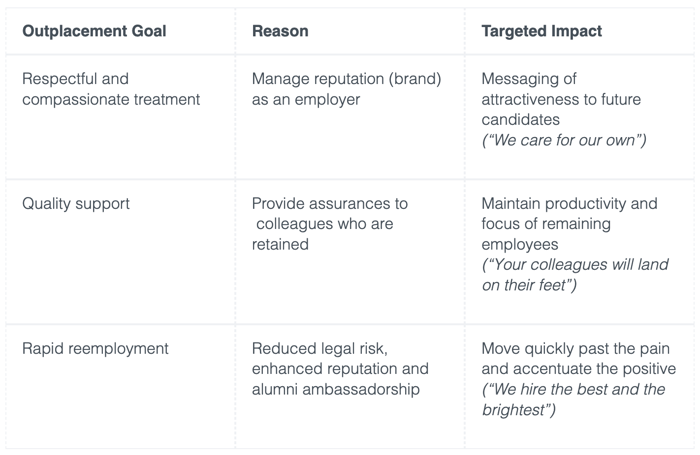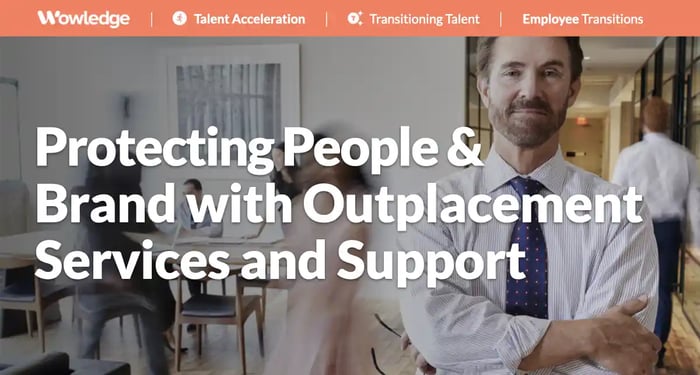Table of Contents
- Poorly executed layoffs can cause significant reputational harm
- Understanding outplacement services and support
- The benefits of providing great outplacement services and support
- Typical outplacement services and support offerings
- Establish a solid foundation for determining the services and support to offer
- Best practices that differentiate effective outplacement services and support
- 1. Deliver a respectful farewell
- 2. Include one-on-one, high-touch support
- 3. Create an outplacement plan for the individual
- 4. Identify a professional brand to promote
- 5. Provide resume optimization tools and coaching
- 6. Offer networking skills guidance and development
- 7. Guide social media strategies, actions
- 8. Support interview preparation
- 9. Leverage modern technologies
- 10. Measure outplacement outcomes
- Choosing an outplacement provider
- Relevant Practices & Tools
Organizational layoff trends continue to plague employees across various industries, with both the private and public sectors experiencing significant job losses at near-record levels. For example, according to Challenger, Gray & Christmas's most recent report, through the third quarter, companies have announced 892,362 job cuts, the second-highest level since the 2008 “Great Recession”. The greatest pain is being felt in the federal government, technology, financial, warehousing, consumer products, pharmaceutical, and retail sectors. The reasons? Government cutbacks, market and economic conditions, facility closures, or the adoption of advancing technologies are among the rationales many employers cite. All of those job losses inevitably prompt necessary conversations about the need for high-quality outplacement services and support, as workers across all functions and job levels will need to find new jobs while navigating volatile, uncertain job markets.
With post-COVID layoffs disproportionately affecting HR roles, there may be fewer internal HR staffers available to support layoffs, making outsourced outplacement services even more appealing and necessary. However, SHRM reports that only 44% of organizations offer those benefits for most, if not all, terminations. Equally concerning is Challenger Gray’s finding that only 29% of organizations even have a formal offboarding process that defines how released employees will be supported during and after their transition.
Poorly executed layoffs can cause significant reputational harm
The realities of layoff activities are that when they are handled poorly or provide insufficient outplacement services and support, they can significantly drive negative perceptions about the company’s employment and commercial brand reputations. This can occur in two significant ways: with future job candidates and with current or potential customers.
As the impact on terminated employees can be extensive and lasting, with resulting psychological, financial, and family distress, it is crucial to address this issue effectively. Aside from any moral considerations, the spread of negative reviews on social media can be rapid, enduring, and highly influential, potentially devastating an employer’s brand and employee value proposition. CareerArc reported that negative reviews prompted by poor layoff experiences have nearly doubled, to 66%. With 91% of active job hunters searching online for ratings of employer reputations before they apply or accept an offer, the likelihood that those negative reviews will impact the perceptions of a vast majority of a company’s candidate pool is substantial. Less than a quarter of all those surveyed said they would apply to a company with low ratings.
A second element is the potential negative impact on a company’s commercial brand and reputation. Research has found that 64% of consumers have stopped purchasing from a brand after learning about a company’s poor treatment of its employees. This effect is more pronounced among younger workers, who now dominate the labor force, as Millennials are 30% more likely to stop purchasing or promoting an employer’s products due to a poor employee experience. There are other negative side effects of poor offboarding and outplacement services and support that fail to meet the basic needs of impacted employees, including the potentially chilling effect on colleagues who retain their jobs. Aside from the inevitable shifting of workloads and responsibilities to the remaining team members, how the laid-off workers are treated is the best predictor of the organization’s future activity. With the risk of job loss fresh in their minds, performance and productivity losses are accompanied by an increased likelihood of job-seeking and turnover as a protective measure.
Understanding outplacement services and support
Outplacement services and support, alternatively known as “career transition services”, “employment transition”, or “employment separation support”, refer to the formal, employer-sponsored provision of a set of services designed to support the preparation, search, and acquisition of a replacement job with another employer. These are most typically offered to affected workers, free of charge as a benefit, and delivered by a third-party firm that specializes in supporting the job searches and related needs of recently separated employees.
Those services and support are designed to assist former employees in locating and securing new jobs that are suitable, given their education, experience, skills, and reasonably match or improve their prior job level, salary, benefits, and work location. The reasons companies offer outplacement services and support typically center on meeting industry benefit standards, acknowledging their previous contributions, communicating concern and care for the benefit of impacted and remaining workers, managing public perceptions, and addressing potential legal risks. These are typically offered in conjunction with severance pay and the continuation of welfare benefits.
The most basic outplacement services and support elements typically cover resume updating, interview tips and training, job search skills and resources, and even some level of counseling. These are often delivered via web-based methods that offer access to e-learning, tools, and resources, with a wide range (from none to continuous) of live, in-person support. Generally speaking, the higher the (previous) job level, the more comprehensive and personalized the support provided.

The benefits of providing great outplacement services and support
The value proposition of offering a robust, comprehensive package of services is substantial, with the primary driver being a faster, better landing for affected employees. The sooner those individuals secure suitable new jobs, the lower the likelihood of negative postings and ratings on social media, the risk of legal challenges, and the losses in productivity, performance, and employee retention among those who remain.
In fact, research from Career Arc has demonstrated that laid-off employees who received outplacement or career assistance were 38% less likely to maintain a negative perception of the company, and stated that they were three times (3X) more likely to continue buying its products or services. Furthermore, leaders and managers who reported that their outplacement programs provided high levels of support were more likely to achieve rapid reemployment and receive higher salaries in their new jobs than those who reported lower levels of support.
The type and quality of outplacement services and support also matter, as having a comprehensive job search strategy increases the number of job offers generated and the subsequent quality of the new job. Similarly, the Federal Reserve Bank of St. Louis found that highly effective professional and personal networking strategies generated significantly more job offers, shortened the time to find a new job, led to higher pay, and resulted in longer subsequent job tenure. The value of comprehensive outplacement services and support cannot be overstated, yet the differences between typical services and those that drive faster, more effective job searches are substantial.
Typical outplacement services and support offerings
As established earlier, only 44% of companies offer outplacement support during layoffs, and even fewer have well-defined offboarding processes. And while the most basic services provide some level of needed support, they often leave displaced workers wanting more. The most common services included when external outplacement support is provided include:
- Resume update guidance. These are often offered through online guides, group presentations, eLearning, or coaching sessions, or individualized review and feedback from resume specialists. Oftentimes, the content is limited, with a focus on the length and spacing of the resume, listing skills and specific achievements, and optimizing the resume for automated and AI-supported screening technologies.
- Job search strategies. These are generalized approaches to identifying the search criteria for a new role and employer, choosing the best places and platforms for marketing oneself, targeting the types of organizations to approach, and determining the number and types of applications to submit. These are often delivered en masse, through eLearning programs or virtual and in-person group sessions. Some organizations offer a (often limited) number of one-on-one coaching sessions that are often generic and less tailored to the individual’s specific circumstances and needs.
- Networking preparation. This is commonly presented as a must-do activity and focuses on developing an “elevator pitch,” making meeting requests, and identifying people to target. The guidance is often generic and rarely addresses how to overcome the realities stemming from individual traits (e.g., introversion) or from changing industries or careers.
- Digital submission advice. Generalized guidance on leveraging social media can be provided through online guides, e-learning videos, or live presentations. Content includes optimizing a professional profile and highlighting unique capabilities and accomplishments. These offer insights into best practices for a variety of promotional and networking activities on sites such as LinkedIn, Facebook, and X.
- Application communications templates. Much like a resume, effectively communicating with potential networking targets and employers is a crucial skill for job seekers. Content is often standardized, with language and templates for requesting meetings and consideration, applying for jobs (e.g., cover letters), and in-process communications (e.g., thank-you or follow-up questions and materials).
- Interview preparation. Basic guidance is provided through videos, self-paced eLearning, and virtual or in-person group training sessions. These cover generalized insights into what to expect, optimized question response patterns, how to handle tough questions, and the legal rights of job candidates.
Many of these approaches meet the “visual” test for completeness, but former employee satisfaction and job search effectiveness last only until they start using those services. Many questions arise, and the need for more personalized support and tailored strategies emerges as the needs of laid-off workers multiply across career fields, job and experience levels, and personal styles. The unique, highly individualized needs of workers with low availability (e.g., executives, senior management), declining employment (e.g., programming, call center, customer service), and highly competitive but limited (e.g., management consulting, professorship) roles require more tailored guidance, feedback, and support.

Establish a solid foundation for determining the services and support to offer
When defining the requirements for outplacement services and support, and the steps to prepare for a reduction in force, several strategically critical factors should be considered, starting with the need to clarify the objectives of the effort. The starting point should be to articulate three goals designed to drive business-critical outcomes, as illustrated below:

There are numerous benefits of creating a comprehensive and responsive offboarding and outplacement process, with the biggest being:
- Easing the transition out of the organization, given the minimal notice provided
- Addressing the realities of job search timeframes
- Signaling a culture of caring for employees to key stakeholders
- Acknowledging the value and contributions of affected employees during their tenures
- Turning former employees into future ambassadors
- Mitigating legal risk
Best practices that differentiate effective outplacement services and support
All too often, especially in the case of significant layoffs, companies focus on being able to say they are offering services to impacted employees without due consideration for the broader objectives of high-quality outplacement efforts. That mentality can lead to providing surface-level, self-directed, one-size-fits-all approaches that are not supportive of individual circumstances, strengths, preferences, or alternative career or job options.
To build a robust offboarding strategy with quality outplacement support as a core element, a strategic and comprehensive view is required. Consider that layoffs represent a very personal experience for each affected employee. As such, the approach to outplacement should be designed to support them as individuals with unique needs.
1. Deliver a respectful farewell
Treating the affected individuals with compassion and respect is often seen as a “moment that matters” to departing (and many remaining) employees, and can reduce the discomfort, frustration, and possible anger that follows the decision. It starts with a well-prepared manager and a formally documented step-by-step process. It involves a respectful and compassionate handling of the departure from the premises, the collection of company property, and the provision of a list of resources available immediately to support their transition. It includes access to an alumni network for networking and support.
2. Include one-on-one, high-touch support
Employees impacted by layoffs experience a loss of status, esteem, and financial stability that most find difficult to process and navigate. The presence or availability of an expert(s) to guide them through such circumstances can serve as a safe harbor against otherwise stormy seas. While the amount of coaching or advisory support offered will vary by prior job level, speaking with someone directly can have a calming effect that online reading or virtual sessions cannot replicate. Offer coaching by specialists in each stage of the process, and group support sessions with other laid-off individuals at similar levels or professions. This allows for personalized outplacement services and support that provide guidance and answers tailored to the individual’s circumstances and needs.
3. Create an outplacement plan for the individual
A strategy should be developed to guide the new job seeker's actions. The plan should include steps that require the job seeker to consider their career goals, role, and work location preferences, as well as career choices and alternatives, including career “pivots,” before they launch into networking and job applications. The plan should include a period of self-reflection, industry and career field research, and the building of a networking plan to identify individuals and the types of people who can educate, make introductions, and refer them to jobs.
4. Identify a professional brand to promote
Articulate what defines the individual, professionally and personally, and the unique identity they want to promote to potential employers. Convey the values and the image that characterize how they present themselves, perform their duties, solve problems, and approach challenges. Use that statement in promotional action plans to communicate it consistently across platforms (e.g., job applications, social media, articles, and presentations) to establish credibility, present expertise, and share perspectives with potential employers and referrers.
5. Provide resume optimization tools and coaching
Go beyond simple editing, updating, or one-time, standardized review and feedback actions on an existing resume. Provide resources that help job seekers reconstruct their resumes to meet current standards using intelligent technologies and rewrite the content based on preferred tasks and activities. Tailor the document for different job opportunities by incorporating keywords from job listings into skill and accomplishment descriptions to increase the likelihood of passing through ATS and AI screening filters. Have the resulting drafts reviewed and guided by coaches who are specialized experts in candidate-job matching technologies.
6. Offer networking skills guidance and development
Provide coaching and training in the most effective career networking strategies and tactics. Build plans to reconnect with current and former colleagues and contacts, identify and engage targeted (new) connections, and expand a broader network of influential and informative individuals who can serve as advisors and referral sources. Use coaching to tailor and refine techniques for successfully approaching and engaging potential new contacts, and for effectively following up and managing ongoing relationships.
7. Guide social media strategies, actions
Provide education and guidance on effectively leveraging social media to promote individual capabilities and the business value proposition, and to create a profile that communicates the brand, experiences, and ability to contribute to specific business needs. Assist the individual with coaching on when, how often, and how to identify topics when creating posts and commenting on others' posts. Support them in understanding how to request connections, reach out to contacts, and contact hiring managers for a specific purpose.
8. Support interview preparation
Deliver training on successfully navigating a multitude of job interviews, understanding and preparing for the wide range of variability in interviewer skills, abilities, and techniques employed. Provide tailored guidance and support for meeting with recruiters, hiring managers, and potential peers in single opportunities and across companies. Support coaching through mock interviews and expert feedback, ideally with unlimited preparatory support before and after each one. Encourage the creation and sending of tailored thank-you and follow-up notes that express appreciation and interest, and fill in any gaps in experience or skills that might have been left unstated.
9. Leverage modern technologies
Use contemporary systems that can automatically generate tailored resumes, cover letters, thank you notes, and follow-up letters that support the candidacy based on a mapping between the job posting and skills/experience requirements versus the individual’s resume. Use AI and related relevance-matching capabilities to help affected workers better identify opportunities that more closely align with their expertise and aspirations. Introduce aspirants to external resources that can serve as sources for preparation and inspiration to create targeted cover letters and follow-up points of view that demonstrate how they would approach job challenges and goals (e.g., Wowledge for HR executives and professionals).
10. Measure outplacement outcomes
Always prepare to assess the effectiveness of outplacement support for use in communications and brand management to key stakeholders in the staff reduction process—top executives, remaining employees, and the community. Use these to gauge program success and identify lessons learned for future force reductions. Key outcome metrics include the ongoing percentage of those landing new jobs, former employee satisfaction, and laid-off worker participation rate.
Choosing an outplacement provider
The identification and selection of providers for outplacement services and support are crucial to success, as the downsides of a poorly executed program can be substantial. Having comprehensive, perceived as satisfactory, and effective support for rapidly re-employing the majority of workers is essential to maintaining market and employment brand reputations and managing legal risk. As such, look for providers with:
- Deep expertise and a long-established reputation as a specialist who generates results
- A range of services and resources that meet the needs of employees at all levels
- Personalized support offering individualized counseling and coaching
- Blended use of innovative technologies that make job searches efficient
- Proven ability to scale across dispersed employee populations in different industries
- A cadre of highly qualified coaches with job search expertise and high emotional intelligence
- Billing model based only on laid-off workers who use the services
- Strong financial stability to ensure the ability to provide contracted support
Relevant Practices & Tools
Emerging HR Strategy Practices for Engaging Employees and External Partners Now and Into the Future. >
At its most sophisticated level, HR Strategy defines a future centered around optimizing how employees and their needs are managed and how critical external resources and relationships can best be leveraged to effectively drive productivity, retention, and business results... more »
Leveraging Outsourcing for Cost-effective Services and Solutions. >
A key element of planning HR strategies involves the decision to build internal capabilities vs. outsource those to a partner organization... more »
Engaging External Executive Coaches and Internal Mentors to Build Leadership Capability. >
When creating a coaching and mentoring capability focused on leaders, best practices suggest starting with the use of experienced external coaches to focus the initial applications of this development practice on the development of top leadership... more »
Collecting Robust Performance Feedback for Increased Reliability and Validity. >
While traditional performance reviews rely on the observations of a single functional manager, many other individuals can provide useful insights into an individual’s job performance... more »
The Value Ranking of Employees Tool: Capture and Compare the Total Value of Employees’ Contributions to the Organization. >
A template to assist with the understanding and ranking of the total value that each employee brings to the organization based on their ongoing performance, contributions, capabilities, growth, and potential for higher-level positions in the future... more »










